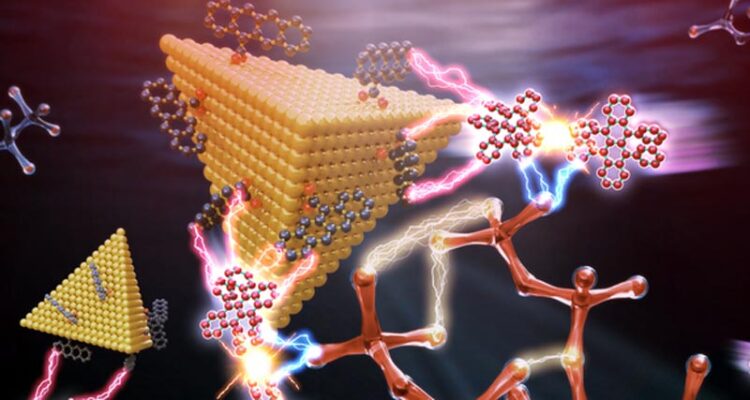Upconversion of infrared photons…

Near-infrared photon upconversion and solar synthesis using lead-free nanocrystals
Credit: DICP
… enables rapid organic synthesis under sunlight.
A research group led by Prof. WU Kaifeng from the Dalian Institute of Chemical Physics (DICP) of the Chinese Academy of Sciences (CAS) has reported the efficient near-infrared photon upconversion sensitized by lead-free semiconductor nanocrystals, and demonstrated its novel application in solar synthesis.
The study was published in Nature Photonics on Feb. 6.
Upconversion of near-infrared photons to visible photons can boost the performance of photovoltaics, photoredox-catalysis and phototheranostics. Sensitized triplet-fusion is a promising means for photon upconversion.
However, current photosensitizers capable of near-infrared absorption often contain either precious or toxic elements, for example, palladium- or platinum-complexes and lead chalcogenide nanocrystals.
In this study, the researchers reported zinc-doped CuInSe2 nanocrystals as a low-cost and environmentally-benign sensitizer for near-infrared-to-visible upconversion, which achieved external quantum efficiency of 16.7% for this spectral range.
This upconversion system was further merged with photoredox catalysis, enabling reductive dehalogenation, amine oxidation, carbon-oxygen bond formation and photopolymerization efficiently driven by near-infrared photons.
More importantly, thanks to the broadband light capturing of the near-infrared nanocrystals, these reactions were remarkably rapid under indoor sunlight, enabling, for example, polymerization of acrylates within just 30 seconds.
“Organic synthesis under sunlight, or solar synthesis, has been a century-long idea, which was pioneered by Ciamician et al. But organic chemists’ vision has been limited to utilizing visible photons in sunlight,” said Prof. WU. “Our study extends the reach of solar synthesis to both visible and near-infrared photons abundant in sunlight, which is poised to strongly boost this technology.”
Journal: Nature Photonics
DOI: 10.1038/s41566-023-01156-6
Method of Research: Commentary/editorial
Subject of Research: Not applicable
Article Title: Near-infrared photon upconversion and solar synthesis using lead-free nanocrystals
Article Publication Date: 6-Feb-2023
Media Contact
Jean Wang
Dalian Institute of Chemical Physics, Chinese Academy Sciences
wangyj@dicp.ac.cn
Office: 41182464221
All latest news from the category: Life Sciences and Chemistry
Articles and reports from the Life Sciences and chemistry area deal with applied and basic research into modern biology, chemistry and human medicine.
Valuable information can be found on a range of life sciences fields including bacteriology, biochemistry, bionics, bioinformatics, biophysics, biotechnology, genetics, geobotany, human biology, marine biology, microbiology, molecular biology, cellular biology, zoology, bioinorganic chemistry, microchemistry and environmental chemistry.
Newest articles

High-energy-density aqueous battery based on halogen multi-electron transfer
Traditional non-aqueous lithium-ion batteries have a high energy density, but their safety is compromised due to the flammable organic electrolytes they utilize. Aqueous batteries use water as the solvent for…

First-ever combined heart pump and pig kidney transplant
…gives new hope to patient with terminal illness. Surgeons at NYU Langone Health performed the first-ever combined mechanical heart pump and gene-edited pig kidney transplant surgery in a 54-year-old woman…

Biophysics: Testing how well biomarkers work
LMU researchers have developed a method to determine how reliably target proteins can be labeled using super-resolution fluorescence microscopy. Modern microscopy techniques make it possible to examine the inner workings…





















